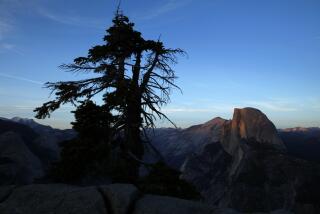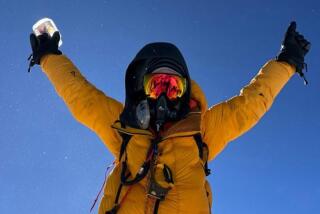Warren J. Harding, 77; First Man to Scale Yosemite’s El Capitan
Warren J. Harding, a pioneer rock climber who made the first ascent of Yosemite’s towering El Capitan in 1958, a breakthrough that ushered in “big wall” climbing in America, has died. He was 77.
Harding died of liver failure Feb. 27 in his home in Happy Valley, near Anderson in Shasta County.
Nicknamed “Batso” by a fellow climber in the early 1970s--for his hanging off rock walls like a bat--the 5-foot-6 Harding was an iconoclastic California character known for his courage, flair and sense of humor.
Harding, who once described rock climbers as “glorified flagpole sitters,” dined on a Thanksgiving turkey his mother had baked for him after hauling it up 600 feet by rope to his bivouac on a ledge during his historic El Capitan climb.
He made his living as a land surveyor on roads, highways and subdivisions. But it was while hanging precariously, often for days, on sheer granite cliffs in Yosemite that he became a legend.
In a climbing career that spanned the 1950s through the ‘70s, the sport’s golden age, Harding made 30 first ascents in Yosemite. Among the most significant: the south face of Half Dome, two routes on El Capitan (the Nose and the Wall of the Early Morning Light), and the west face of the Leaning Tower.
“Basically, he took climbing to another level in the late ‘50s by daring to go up and spend long periods of time on the big faces in Yosemite when no one had ever done so,” said photographer Galen Rowell, who was Harding’s climbing partner on the Half Dome climb in 1970.
Harding and a series of partners made the famous 1958 ascent of El Capitan via the so-called Nose route. Reaching the top took 45 days of climbing, which they did in stages over 18 months, leaving fixed lines down to the ground for easy access when they went back up.
The last nine days of the climb in November 1958, with partners George Whitmore and Wayne Merry, were spent continuously on the upper part of the wall, the longest time anyone had ever spent on a wall up to that point.
To conquer the 3,000-foot monolith, Harding used 600 pitons (small spikes with eyes for safety ropes that are driven into natural cracks in the rock), and he drilled 125 holes for expansion bolts on blank parts of the cliff where pitons could not be used.
Harding’s use of expansion bolts sparked a controversy among climbers.
“Some climbers felt that if you couldn’t use all the natural features on the rock that you should not do the climb,” Rowell said. “Warren had a libertarian view of climbing and said, ‘That’s just a beautiful face and I want to do it.’
“He was very bold and very determined and thought climbing was one of the last places in North America where you could be totally free and make your own decisions, and he went for it.”
The expansion-bolt controversy grew in 1970 when Harding and partner Dean Caldwell spent 27 days climbing the Wall of the Early Morning Light, a blank section of El Capitan about 200 feet east of the Nose.
Whereas he had used 125 expansion bolts in his 1958 climb, Harding used 300 on the 1970 climb.
The two men had planned to reach the summit in 12 days, but rain and freezing temperatures slowed their progress. At one point, the National Park Service decided the two climbers needed to be rescued, but Harding and Caldwell refused to come down.
The climb attracted the intense interest of curiosity seekers and the print and television media, which followed their daily progress.
At the time, the Wall of the Early Morning Light--so named because it catches the first rays of the rising sun--was one of the few remaining unconquered routes in Yosemite.
When Harding began climbing in the early 1950s, Rowell said, virtually none of the major rock faces in North America had been climbed.
“So it was an open field for somebody like Warren who had boundless energy and desire to do those kinds of things,” he said.
The Oakland-born Harding, whose father worked for the state Department of Highways, grew up in Downieville and Marysville. During World War II, he worked as a propeller mechanic at Sacramento’s McClellan Field. As a surveyor after the war, he worked first for the state and then for private construction firms.
Harding, who always enjoyed the outdoors, didn’t start climbing until he was 30.
Fellow climber Steve Roper remembers Harding’s penchant for having a good time, even while suspended hundreds of feet from the floor of Yosemite Valley.
Whereas other climbers would eat a can of tuna or a candy bar on a climb, Roper said, “he always hauled up good food and wine.”
Handsome, with jet black hair in his prime, Harding was known for driving fancy sports cars, often having a good-looking woman on his arm, and drinking red wine from gallon jugs. At one point he took to wearing Army fatigues, which he dyed black and wore with a black turtleneck, a look some of the younger climbers emulated.
Harding wrote a whimsical autobiography in 1975, “Downward Bound,” and created a climbing tent and other equipment for his own climbs produced by what he called BAT (Basically Absurd Technology).
“To him, climbing was for fun, and he didn’t like people to take themselves too seriously about climbing,” said Alice Flomp, Harding’s companion since 1985.
After his retirement as a surveyor in 1989, Harding became the oldest man to climb El Capitan, ascending the Nose route he had pioneered. He was 65.
In recent years, Harding and Flomp’s mobile home in Happy Valley, on more than an acre studded with pine and oak trees, often drew visits from young rock climbers.
But in his final days, it was Harding’s old climbing pals who stopped by. Rowell visited Harding three days before he died.
At first, according to Rowell, the gravely ill Harding “didn’t say a word.”
But then Rowell read Harding a letter he had received from a friend who had always admired Harding and wanted to write about him for a biker magazine. He didn’t care if Harding had never ridden a Harley, the writer said; “he was the biker mystique personified.”
“I finally said, ‘Warren, can you hear me?’ He was almost in a coma. ‘Can you nod or something?’ Warren opened his eyes and looked me in the eye for about five seconds and said, ‘I want wine.’ I spoke to Alice. She said, ‘Well, it can’t hurt him now. Here’s a jug of red, go give him a glass.’ I put it up to his lips and he drank it.
“He basically walked the walk all the way to the end.”
Harding is survived by a sister, Ardeth Barber of West Sacramento.
A memorial service is scheduled for noon Sunday in the VFW Hall, 905 Drever St., West Sacramento.
More to Read
Sign up for The Wild
We’ll help you find the best places to hike, bike and run, as well as the perfect silent spots for meditation and yoga.
You may occasionally receive promotional content from the Los Angeles Times.






